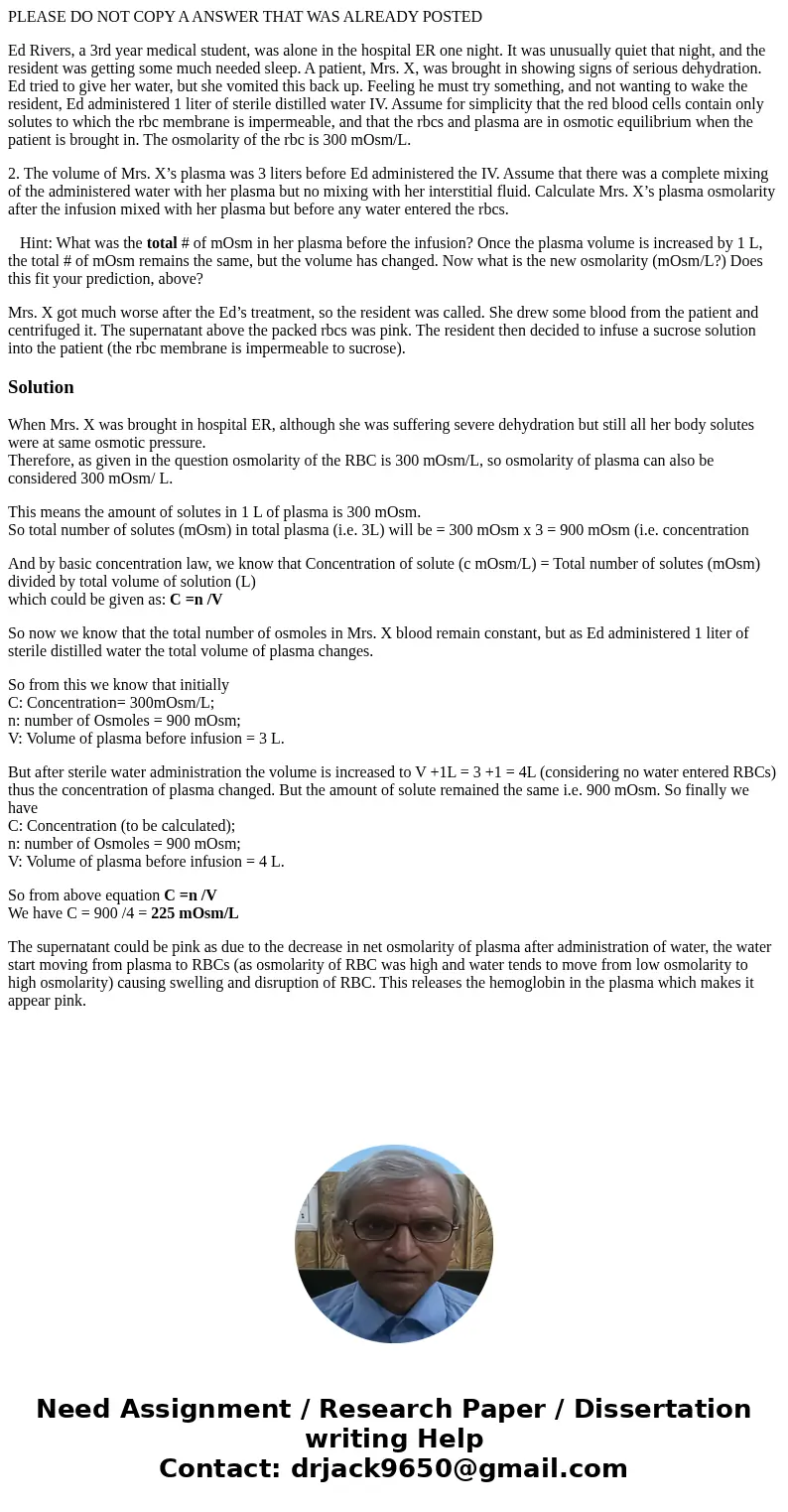PLEASE DO NOT COPY A ANSWER THAT WAS ALREADY POSTED Ed River
PLEASE DO NOT COPY A ANSWER THAT WAS ALREADY POSTED
Ed Rivers, a 3rd year medical student, was alone in the hospital ER one night. It was unusually quiet that night, and the resident was getting some much needed sleep. A patient, Mrs. X, was brought in showing signs of serious dehydration. Ed tried to give her water, but she vomited this back up. Feeling he must try something, and not wanting to wake the resident, Ed administered 1 liter of sterile distilled water IV. Assume for simplicity that the red blood cells contain only solutes to which the rbc membrane is impermeable, and that the rbcs and plasma are in osmotic equilibrium when the patient is brought in. The osmolarity of the rbc is 300 mOsm/L.
2. The volume of Mrs. X’s plasma was 3 liters before Ed administered the IV. Assume that there was a complete mixing of the administered water with her plasma but no mixing with her interstitial fluid. Calculate Mrs. X’s plasma osmolarity after the infusion mixed with her plasma but before any water entered the rbcs.
Hint: What was the total # of mOsm in her plasma before the infusion? Once the plasma volume is increased by 1 L, the total # of mOsm remains the same, but the volume has changed. Now what is the new osmolarity (mOsm/L?) Does this fit your prediction, above?
Mrs. X got much worse after the Ed’s treatment, so the resident was called. She drew some blood from the patient and centrifuged it. The supernatant above the packed rbcs was pink. The resident then decided to infuse a sucrose solution into the patient (the rbc membrane is impermeable to sucrose).
Solution
When Mrs. X was brought in hospital ER, although she was suffering severe dehydration but still all her body solutes were at same osmotic pressure.
Therefore, as given in the question osmolarity of the RBC is 300 mOsm/L, so osmolarity of plasma can also be considered 300 mOsm/ L.
This means the amount of solutes in 1 L of plasma is 300 mOsm.
So total number of solutes (mOsm) in total plasma (i.e. 3L) will be = 300 mOsm x 3 = 900 mOsm (i.e. concentration
And by basic concentration law, we know that Concentration of solute (c mOsm/L) = Total number of solutes (mOsm) divided by total volume of solution (L)
which could be given as: C =n /V
So now we know that the total number of osmoles in Mrs. X blood remain constant, but as Ed administered 1 liter of sterile distilled water the total volume of plasma changes.
So from this we know that initially
C: Concentration= 300mOsm/L;
n: number of Osmoles = 900 mOsm;
V: Volume of plasma before infusion = 3 L.
But after sterile water administration the volume is increased to V +1L = 3 +1 = 4L (considering no water entered RBCs) thus the concentration of plasma changed. But the amount of solute remained the same i.e. 900 mOsm. So finally we have
C: Concentration (to be calculated);
n: number of Osmoles = 900 mOsm;
V: Volume of plasma before infusion = 4 L.
So from above equation C =n /V
We have C = 900 /4 = 225 mOsm/L
The supernatant could be pink as due to the decrease in net osmolarity of plasma after administration of water, the water start moving from plasma to RBCs (as osmolarity of RBC was high and water tends to move from low osmolarity to high osmolarity) causing swelling and disruption of RBC. This releases the hemoglobin in the plasma which makes it appear pink.

 Homework Sourse
Homework Sourse